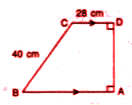In the given figure, ABCD is a rhombus with angle A = 67∘.

If DEC is an equilateral triangle. Calculate :
(i) ∠CBE (ii) ∠DBE
The correct Answer is:(i) 26⋅5∘ (ii) 30∘
Step by step video & image solution for In the given figure, ABCD is a rhombus with angle A = 67^(@). If DEC is an equilateral triangle. Calculate : (i) angleCBE" (ii) "angleDBE by Maths experts to help you in doubts & scoring excellent marks in Class 9 exams.
Updated on:21/07/2023Topper's Solved these Questions
- RECTILINEAR FIGURESBOOK - ICSECHAPTER - RECTILINEAR FIGURESEXERCISE - QUADRILATERALS AND ITS PROPERTIES - 3 MARKS QUESTIONS
8 Videos
- RATIONAL AND IRRATIONAL NUMBERS BOOK - ICSECHAPTER - RATIONAL AND IRRATIONAL NUMBERS EXERCISE - EXERCISE 1 (D)
21 Videos
- SIMULTANEOUS EQUATIONSBOOK - ICSECHAPTER - SIMULTANEOUS EQUATIONSEXERCISE - EXERCISE 6 (G)
13 Videos
Similar Questions
In the given figure, ABCD is a rhombus with angle A=67∘

If DEC is an equilateral triangle, calculate:
∠DBE
View SolutionIn the given figure, ABCD is a rhombus with angle A=67∘

If DEC is an equilateral triangle, calculate:
∠CBE
View SolutionIn the given figure, ABCD is a rohombus with A=67∘. If DEC is an equilateral triangle, calculate
(i) ∠CBE
(ii) ∠DBE

View SolutionIn the adjoining figure, ABCD is a rhombus and ABE is an equilateral triangle. If ∠BCD=70∘, find
(a)∠ADE (b)∠BDE (c)∠BED

View SolutionThe given figure shows a rhombus ABCD. Find x and y

View Solution
ABCD is a rectangle.
If ∠BPC=124∘.
Calculate:
(i) ∠BAP
(ii) ∠ADP.
View SolutionThe given figure shows a square ABCD and an equilateral triangle ABP.

Calculate :
(i) ∠AOB
(ii) ∠BPC
(iii) ∠PCD
(iv) reflex ∠APC
View SolutionIn the given figure, ABCD is a trapezium with angle C=120∘,DC=28 cm and BC=40 cm. Find :

(i) AB
View SolutionThe given figure shows a square ABCD and an equilateral triangle ABP. Calculate:

∠BPC
View SolutionThe given figure shows a square ABCD and an equilateral triangle ABP. Calculate:

∠AOB
View Solution
